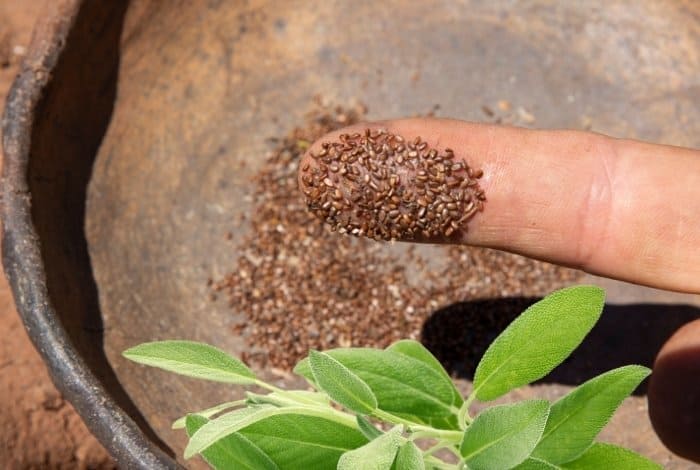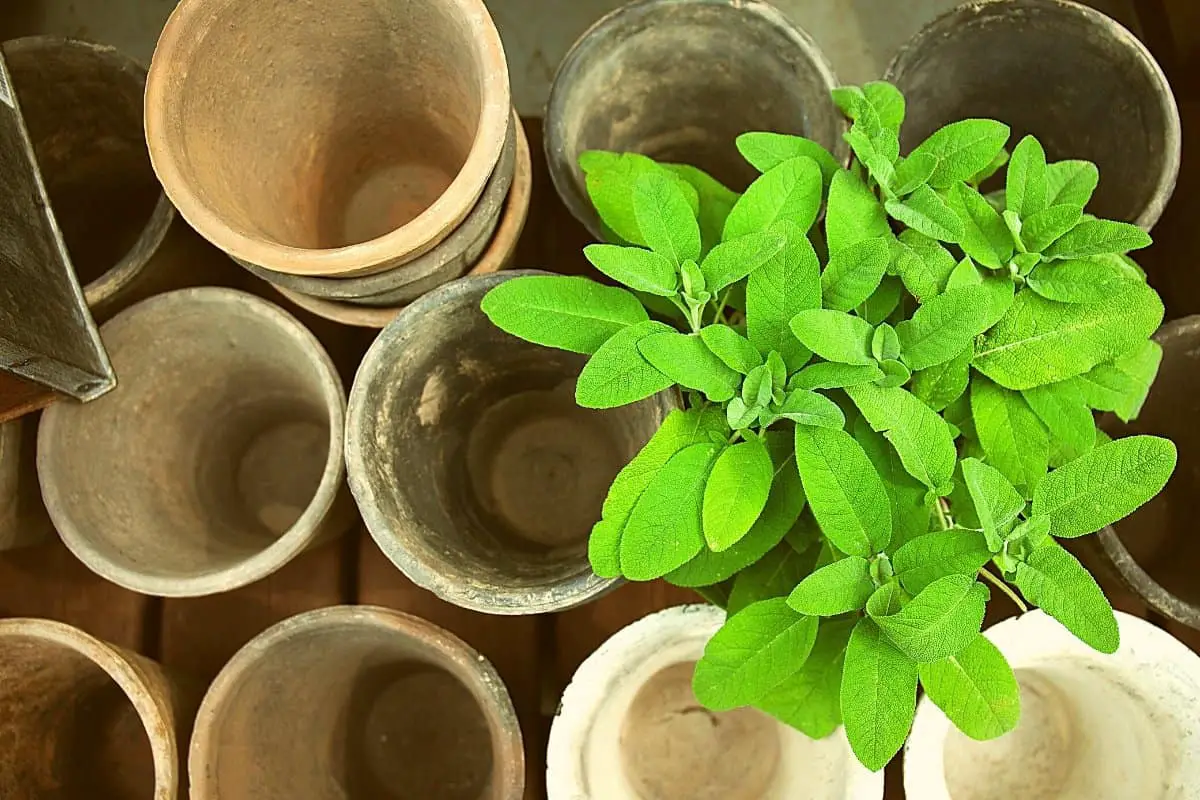Last Updated on January 17, 2023 by Urska
It is important to learn how to grow common sage from seed to undertake the fun journey of growing this culinary superstar.
Sage is a pretty low shrub with pale velvet-soft grayish-green leaves. It is a member of the mint family and very easy to grow. Sage does well both indoors and outdoors. If you are looking to add on a new herb to your garden this year, get sage.
Sage is a highly aromatic herb with an earthy subtle flavor. It works well with meats like port, poultry, and lamb. Often used in dressings or holiday stuffings, sage is used sparingly because it is strong and overpowers a dish fast.
It is regarded as a medicinal herb that has been in use for many years to cure many ailments. Plant this herb together with other Mediterranean herbs like rosemary and basil for a delicious and fragrant kitchen.
Let’s Look at How to Grow Common Sage from Seed
- Site preparation. Sage grows in well-prepared garden beds or containers. It requires full sun and tolerates partial shade. Add some organic compost or well-aged chicken manure to well-drained soils before planting.
- Sowing the seeds. Growing sage from seeds needs patience because they take longer to germinate. Scatter the seed over the seed starting soil and cover them with 1/8 inch of soil. Keep the soil damp not soaked in water. The germination process takes up to 6 weeks and not all seeds germinate.
- Planting. Seeds take about 6 weeks to germinate, once they are ready, transplant them to the garden. Transplant seedlings to the garden after all danger of frost have come to an end. Space the sage plants at 2 feet apart and divide them every 3 to 5 years to keep them growing well.
Sage is hardy, it grows up to -30 degrees Fahrenheit. To protect this plant from winter, cut back the foliage and place a thick layer of mulch over the roots. This protects them from freezing.
Read about What is the Difference Between a Nut and a Seed
Common Types of Sage
Some of the most popular varieties are:
- Garden Sage. This is one of the popular varieties also referred to as common sage. It resists extreme cold weather during winters bouncing back to life every spring. It is hardy and resists tough growing conditions. This variety has soft, greenish silvery leaves with purple bluish flowers making this herbal a delight in every garden
- Berggarten Sage. It is very alike to the common garden sage in color, style of leaves, and look but it does not bloom.
- Mealycup Sage. This is one of the most common version also known as blue salvia. It grows about 2 to 3 feet and is often annual but that depends on the region you are growing it in. It has lovely purple, blue, and white flower spikes. Mealycup sage has several varieties like Victoria blue and empire purple.
- Grape Scented Sage. It is one of the largest growing varieties that grow up to 8 feet tall by 6 feet wide. A s the name suggests it does not have a grapes smell rather it smells of freesia. Its leaves and flowers attract hummingbirds and can be steeped to make a sweet tea beverage.
- Golden Sage. This is a creeping plant that has green and golden variegated leaves. It makes the garden look beautiful with colors accentuating the plants growing around it.
Read more about Growing Broccoli from Seed
Sow Right Seeds – Sage Seeds for Planting
Some of the Less Popular Ones
- Purple Sage. This sage has purple leaves when young. Unlike the garden sage, the purple sage bush does not bloom as often.
- White Sage. It is also known as bee sage and is used for cooking. It is a slow grower taking up to 3 years to mature and grow up to 2-3 feet tall.
- Scarlet Sage. This variety thrives in full sun but it also withstands partial shade. It has to be planted on well-drained soil. It has gorgeous scarlet blooms that produce in the late spring and last through the first frost of the year.
- Mexican Bush Sage. It is drought tolerant and grows 3 to 4 feet high. Even though it withstands drought, it is otherwise a tender perennial with purple or white flowers.
- Pineapple Sage. This sage is grown as an ornamental plant and thought to contain medicinal properties. This variety produces tubular red flowers and attracts butterflies and hummingbirds.
- Tricolor Garden Sage. Tricolor sage is alike to purple sage. Its only difference is the uneven white accented leaves giving the perception of being multicolored.

Conclusion
Armed with the facts of how to grow common sage from seed, let’s go and grow it. This useful herb will not leave our food tasting the same. It will be more delicious, all thanks to sage!
FAQs
Is sage easy to grow from seed?
Sage is a popular herb, which is native to the Mediterranean region. The plant serves as an important source of food and medicine for the people living in these regions.
The sage plant has been used as a flavoring agent since ancient times. Its leaves are used in cooking, while it’s flowers are often used as tea or in salads.
Sage is a perennial flower that needs only 2-3 feet of space to grow and it can be easily propagated from its seeds.
It has a low maintenance demand, and it also grows fast. It is a perennial herb that grows most of its parts from seed. This makes it a great plant to grow on your windowsill or garden.
Sage is a perennial herb that grows well on most soil, but it does need some light. It can grow from seed, but it takes around six months to sprout and then another two to three years to flower.
Growing sage from seed is an easy process that takes only a few days, but the rest of the process takes patience.
Here are some things that you can do to ensure that your plants grow successfully:
- Make sure the soil is well-drained and contains plenty of organic matter
- Plant directly into soil to avoid transplant shock
- Sow your sage seeds in a pot with drainage holes or a small garden bed on top of the soil
- Maintain proper moisture levels in the pot so water doesn't condense on the leaves
- Place the pot in full sun for 3 weeks
- If pruning or pinching off does not work, use scissors to cut off dead flowers and stems
Does sage come back every year?
The answer is yes, but there are two factors that change the likelihood of it happening. These factors include how often you plant sage and how long the growing cycle for sage lasts.
Sage usually returns in the springtime. This plant grows with increased light exposure and it becomes more abundant as days become longer and warmer. It’s said that sage comes back every year, even if it’s more than once a year. The sage plant grows back every year in certain locations.
What is a good companion plant for sage?
Sage can be difficult to grow because it does not like shade. A companion plant that thrives in the shade is thyme. Thyme provides both a visual support for sage and helps with insect problems.
Thyme will also help with decreasing the chance of fungus infections on sandy soils where sage may not survive without it as they are usually on different roots or soil mediums.
Other common companion plants for sage include lavender and rosemary. These plants can help shield sage from insects if they are planted nearby. Sage also benefits from being planted near mint or dill due to their cooling properties.
Caroline is a gardener who loves to get down to the nitty–gritty of gardening. She proudly proclaims herself as a ‘dirt worshipper‘ and can often be found deep in the garden, covered in soil and singing to her plants. As a self–proclaimed ‘plant whisperer‘, Caroline believes that plants need love and attention just like any other living thing, and she loves to give them both. When she‘s not tending to her garden, you can often find her researching the latest gardening trends, or teaching others how to make their gardens thrive



